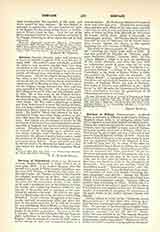

Géry (Lat. GAUGERICUS), Saint, Bishop of Cambrai-Arras; b. of Roman parents, Gaudentius and Austadiola, at Eposium (Yvois, Carignan), France, about the middle of the sixth century; d. August 11, between 623 and 626. The Diocese of Cambrai-Arras is of recent date compared with the more ancient see of Belgium, Tongres, which dates from the fourth century. The territory, which comprised the Diocese of Cambrai-Arras, like that of Tournai and Terouanne, probably contained Christians before the date of the appearance of its first known bishop, St. Vaast, but their spiritual head must have resided at Reims. The great barbarian invasion of 406 completely overthrew the ecclesiastical organization, but from the beginning of the Merovingian period the Church began to recover, the Diocese of Arras especially being restored by St. Vaast about the beginning of the sixth century. Gery was one of his earliest successors. From his youth Gery led a pious and devout life, and already all things combined to prepare him for the career of zeal and devotion which he was to embrace later on. During one of his episcopal visitations, St. Magneric, Bishop of Trier, was struck by the exemplary conduct of the young man, and conceived the project of enrolling him in the ranks of his clerics. Gery was not ordained deacon, say his biographers, until he knew the whole Psalter by heart. The episcopal See of Cambrai-Arras soon became vacant, and Gery was called to fill it. King Childebert II gave his consent and instructed Aegidius, Metropolitan of Reims, to consecrate the new bishop. This installation must have taken place between 585 and 587. Filled with apostolic zeal, Gery devoted his life to the extermination of the paganism which infected the district subject to his authority, and, since the worship of the old gods was deeply rooted in the souls of the barbarous peoples, the bishop destroyed or purchased the idols, which were the objects of their veneration. He erected the church of St-Medard in the chief town of Cambrai. He frequently visited the rural districts and the villce at a distance from his episcopal city, displaying particular solicitude for the ransom of captives.
But political events soon introduced a new dominion, when Clotaire II (d. 629) took possession of Cambrai. The bishop went to pay his respects to the conqueror in his villa of Chelles, probably in 613. At the command of the king he was compelled to go to the sanctuary and national place of pilgrimage of the Franks, St. Martin of Tours, there to distribute alms to the poor. In October, 614, Gery assisted at the Council of Paris. He died after an episcopate of thirty-nine years, and was buried in the church of St Medard at Cambrai. Gery was honored with a cult immediately after his death. In the time of his successor Bertoald his tomb was already the object of fervent veneration, and the monastery of St-Medard which he had founded profited largely by the offerings made to him. Mention of his feast is already made in the additions to the Hieronymic martyrology, and in the ninth century in the martyrologies of Wandalbert of Pram and of Rabanus Maurus. This feast is celebrated on August 11. The institution of the feast of his exhumation, November 18, and of his translation, September 24, dates probably from 1245, as his relics were exhumed in that year by Bishop Guido of Cambrai. Relics of the saint are preserved at Ste-Marie de Liessies, at the Church of St-Gery at Brussels, at the church of the same name at Arras, at St-Donatien at Bruges, at St-Pierre at Douai, and in other churches of Belgium. St-Gery is the patron of Cambrai, subsidiary patron of Brussels, and he is honored as a protector at Braine-le-Comte (Hainaut, Belgium). On the reliquary in the form of an ostensorium at the Cathedral of Cambrai, which contains the skull of St. Gery, he is represented in the attire of a bishop, mitre on head, without his crosier, right hand lifted in a gesture of benediction and left folded upon his breast.
L. VAN DER ESSEN

